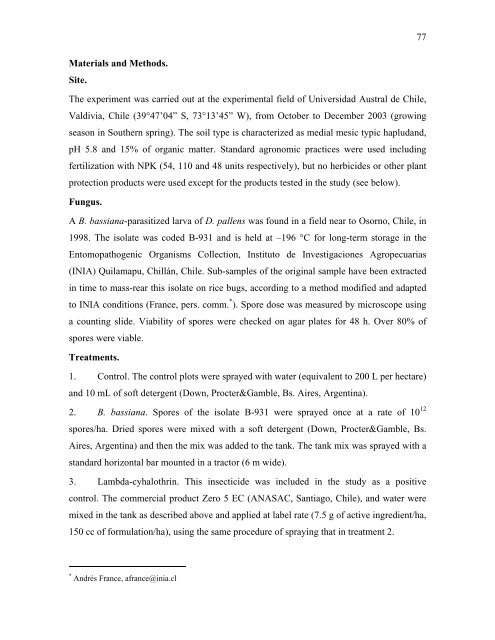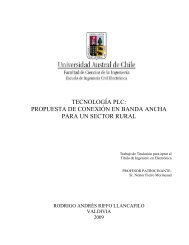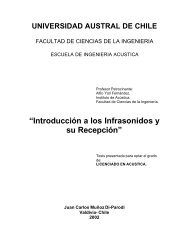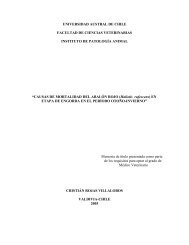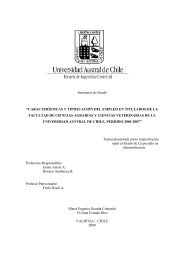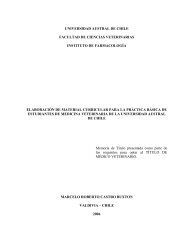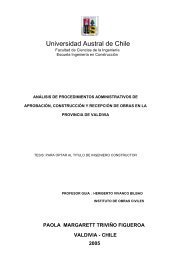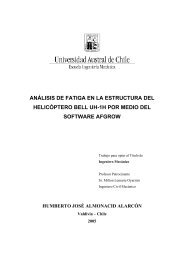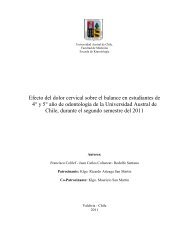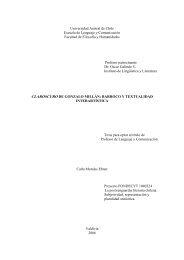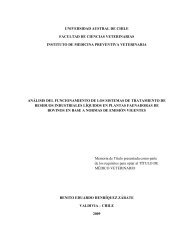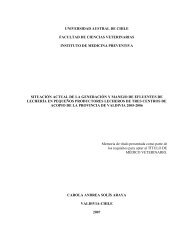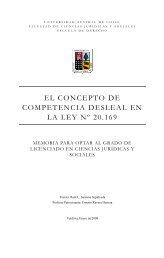Diversidad y control biológico de insectos - CyberTesis UACh ...
Diversidad y control biológico de insectos - CyberTesis UACh ...
Diversidad y control biológico de insectos - CyberTesis UACh ...
You also want an ePaper? Increase the reach of your titles
YUMPU automatically turns print PDFs into web optimized ePapers that Google loves.
Materials and Methods.<br />
Site.<br />
The experiment was carried out at the experimental field of Universidad Austral <strong>de</strong> Chile,<br />
Valdivia, Chile (39°47’04” S, 73°13’45” W), from October to December 2003 (growing<br />
season in Southern spring). The soil type is characterized as medial mesic typic hapludand,<br />
pH 5.8 and 15% of organic matter. Standard agronomic practices were used including<br />
fertilization with NPK (54, 110 and 48 units respectively), but no herbici<strong>de</strong>s or other plant<br />
protection products were used except for the products tested in the study (see below).<br />
Fungus.<br />
A B. bassiana-parasitized larva of D. pallens was found in a field near to Osorno, Chile, in<br />
1998. The isolate was co<strong>de</strong>d B-931 and is held at –196 °C for long-term storage in the<br />
Entomopathogenic Organisms Collection, Instituto <strong>de</strong> Investigaciones Agropecuarias<br />
(INIA) Quilamapu, Chillán, Chile. Sub-samples of the original sample have been extracted<br />
in time to mass-rear this isolate on rice bugs, according to a method modified and adapted<br />
to INIA conditions (France, pers. comm. * ). Spore dose was measured by microscope using<br />
a counting sli<strong>de</strong>. Viability of spores were checked on agar plates for 48 h. Over 80% of<br />
spores were viable.<br />
Treatments.<br />
1. Control. The <strong>control</strong> plots were sprayed with water (equivalent to 200 L per hectare)<br />
and 10 mL of soft <strong>de</strong>tergent (Down, Procter&Gamble, Bs. Aires, Argentina).<br />
2. B. bassiana. Spores of the isolate B-931 were sprayed once at a rate of 10 12<br />
spores/ha. Dried spores were mixed with a soft <strong>de</strong>tergent (Down, Procter&Gamble, Bs.<br />
Aires, Argentina) and then the mix was ad<strong>de</strong>d to the tank. The tank mix was sprayed with a<br />
standard horizontal bar mounted in a tractor (6 m wi<strong>de</strong>).<br />
3. Lambda-cyhalothrin. This insectici<strong>de</strong> was inclu<strong>de</strong>d in the study as a positive<br />
<strong>control</strong>. The commercial product Zero 5 EC (ANASAC, Santiago, Chile), and water were<br />
mixed in the tank as <strong>de</strong>scribed above and applied at label rate (7.5 g of active ingredient/ha,<br />
150 cc of formulation/ha), using the same procedure of spraying that in treatment 2.<br />
* Andrés France, afrance@inia.cl<br />
77


